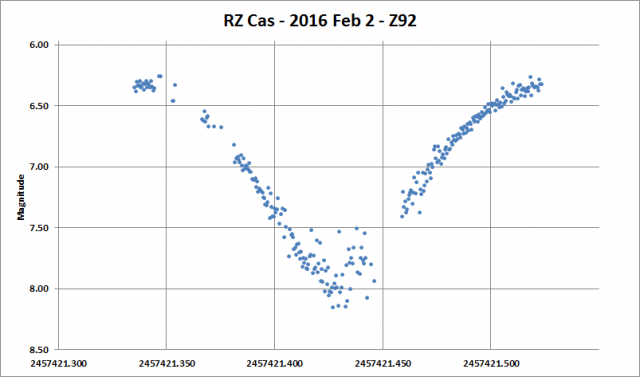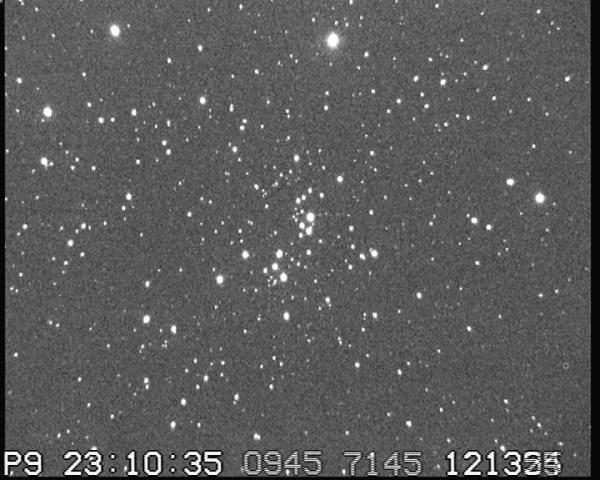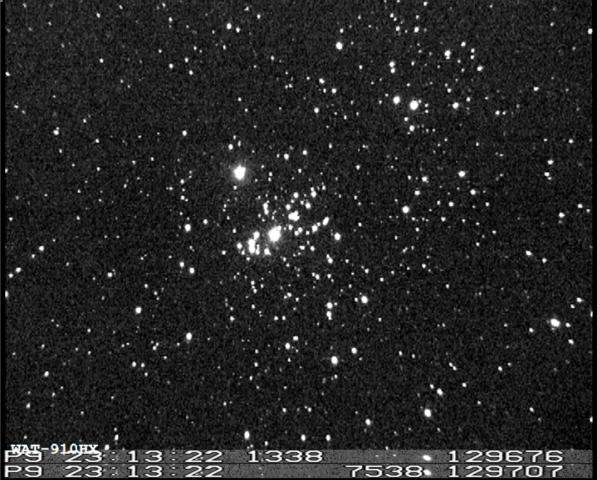› Forums › Photometry › How useful are Video cameras for Photometry
- This topic has 12 replies, 5 voices, and was last updated 5 years ago by
 Alex Pratt.
Alex Pratt.
-
AuthorPosts
-
26 November 2020 at 6:07 pm #574799
Alan P Buckman
ParticipantI am interested in starting video astronomy using a Watec video camera and I am wondering how useful it will be for photometry and magnitude measurements using a reasonable telescope (12 inch). I can see the meteor astronomy use after the excellent tutorial recently but I would like to expand its use by making magnitude estimates and exploring objects with UBVRI filters. There is nothing like corroborating results in catalogues! And what sort of accuracy should I expect.
27 November 2020 at 10:47 am #583398 Alex PrattParticipant
Alex PrattParticipantHi Alan,
Analogue video cameras, such as the Watec 902H2 Ultimate and the more sensitive Watec 910, give 8-bit output, a brightness range of 256 values. They can measure accuracies to 0.1 mag., such as this light curve of a minimum of the eclipsing binary, RZ Cas

obtained using a Watec 910 camera and an old 50mm f/2 SLR lens. Thin cloud caused the large amount of scatter at minimum. Of course, using a telescope would reach fainter targets.
Video dark frame and flat field recordings can be made and used to calibrate the data.
Members of the Variable Star Section use CCD and CMOS cameras for photometry and produce estimates accurate to 0.01 mag. This is because they are using 12-, 14- or 16-bit sensors, with much larger well depths, supporting a significantly greater range in brightness, giving better accuracy. Exoplanet observers take photometry to an even higher level.
It depends what you want to do. Video photometry is useful for transient events with large magnitude drops and for estimating times of minima of eclipsing binaries, but I suggest looking at the VSS webpages and its Members’ Pages if you wish to do good quality UBVRI photometry.
Cheers,
Alex.
27 November 2020 at 12:05 pm #583401 Robin LeadbeaterParticipant
Robin LeadbeaterParticipantLong exposure astro cameras with higher dynamic range are certainly better for photometry but I played around with 8 bit camera photometry a few years back and found it was possible to do high(ish) precision photometry with 8 bit cameras (even exoplanets, just) provided you sum many frames to get the counts. eg
http://www.threehillsobservatory.co.uk/astro/Photometry_GO_Com.htm
http://www.threehillsobservatory.co.uk/astro/TrES_1.htm
One thing to watch though with these cameras is that the gamma is set to 1 so the response is linear.
Cheers
Robin
27 November 2020 at 6:22 pm #583403 Dominic FordKeymaster
Dominic FordKeymasterI’m impressed that you manage to achieve 0.1 mag accuracy!
I have also played around the background subtraction and flat-fielding with my meteor camera, which I use to get as many stars as possible when calibrating the pointing and lens abberations using astrometry.net. But the stars have a tendency to be horribly saturated (which isn’t an issue for me).
Presumably you have to tweak the gain manually for each target, to place the star optimally within the very limited dynamic range you have? I’ve noticed that stars often have quite evident “ringing” artifacts on either side of them, due to a analogue signal losing its higher frequency components, which would be another noise source. The limited number of pixels is another factor that I would imagine might making accurate photometry difficult.
27 November 2020 at 9:21 pm #583408Alan P Buckman
ParticipantThanks Alex and Robin for your comments. I guess I am harking back to the days of PE Photometry using PM tubes and photon counting. I was using this when I worked at the RGO at Herstmonceux for industrial training. in the late 70’s. The idea of attaching a video camera to a variety of lenses to cover fields up to about 20 degrees means I can wander round the sky and view in comfort and have the recording available for later. With the 6 magnitude dynamic range and the variable gain and integrating nature of the camera means I can see possibly down to 10th magnitude with a 200mm telephoto lens which will give splendid sights of large fainter star clusters with the possibility of measuring stellar magnitudes from the recording.
cheers
Alan
28 November 2020 at 11:13 am #583410 Alex PrattParticipant
Alex PrattParticipantAlan,
Here’s an example of a single frame of NGC 884 (Sword Handle, Perseus) from a video taken on 2020 Sep 13 with a Watec 910HX camera on a C11 /f10 with f/3.3 focal reducer. 0.64s integration setting

The field is about 30′ across the diagonal and it shows stars to mag. 15.
It’s fun to observe the brighter star clusters in almost real-time, rather than second hand after spending hours taking hundreds of ‘subs’.
Cheers,
Alex.
28 November 2020 at 1:58 pm #583409 Alex PrattParticipant
Alex PrattParticipantDominic – for video meteors I use UFO Capture and Global Meteor Network‘s RMS (Raspberry Pi Meteor Station) software. Both systems employ a video stars-magnitude formula in their camera profile. UFO doesn’t apply any darks or flats, but RMS applies a flat and corrects for vignetting.
Alan – I use OccuRec for video recording asteroidal occultations, video astrometry and (very occasionally) video photometry of variable stars. They are analysed using Tangra. Its video photometry tab (and the link to Hristo’s article) will be of interest to you. As Robin mentioned, photometry is improved by taking more data; CDD photometrists work with S/N ratios of 100 or more, whereas I need accurate timings of transient events, so I’m usually working with single figure S/N ratios. This example compares video astrometry and photometry with traditional CCD results.
Cheers,
Alex.
30 November 2020 at 10:54 pm #583425Alan P Buckman
ParticipantAlex. Thanks that is brilliant!. That is what I am after. That is more or less exactly the same view as the picture in Burnhams pp 1445. Real time astronomy appeals to me and opens up the possibility to live astro meetings. What device have you to insert the live time and will it take a text string to display other info with the video.
Cheers
Alan
1 December 2020 at 1:05 pm #583426 Alex PrattParticipant
Alex PrattParticipantHi Alan,
Here is a video frame of its neighbour, NGC 869, taken with the same gear, same exposure

I participate in pro-am projects to record occultation events and for astrometry of NEOs. I need accurate timings, so my timestamps are provided by a 1PPS GPS video time inserter. My current model is the IOTA-VTI Basic. Another popular VTI is GPSBOXSPRITE3. They don’t offer the user an option to add text to the video stream. Some enthusiast have built their own VTIs and added this feature.
You don’t need such timing accuracies for photometry, and with your background you could consider options such as this Arduino Project where you could look at adding text to its timestamps. A Raspberry Pi time server is another option.
Cheers,
Alex.
2 December 2020 at 8:54 am #583437Alan P Buckman
ParticipantAlex, Thanks for all the info. I have not come across any of the programmes / methods / equipment that people use apart from the basic video cameras, so this discussion has been very useful in that respect. I know it is old school, I appear to be about 20 years behind, but a tutorial article for the BAA would be great and perhaps persuade more people to take up this great method for visual astronomy which can contribute valuable science if one perseveres.
I looked up the MAX7456 used in the VTI equipment and found it is obsolete from Maxim but there is a Chinese copy. It just makes it harder to enter the field with a piece of equipment as it will require a software development using the sync pulse edge. The Arduino addon uses (used!) the Maxim chip, ok for end user / developers but not for a product.
Thanks again for all the valuable info.
Cheers
Alan2 December 2020 at 12:21 pm #583438 Alex PrattParticipant
Alex PrattParticipantHi Alan,
You don’t need accurate time for your photometry, so I hope you can fettle together some circuitry to embed user text into the video stream.
A look at mine and Tim Haymes’ Members’ Pages shows some of the results from video astronomy. Tim wrote a tutorial on Observing asteroidal occultations with digital cameras, which includes many useful links. My notes on video recording lunar occultations should be on the BAA webpages somewhere; here’s an external link to Guide to video astrometry (it’s in need of revision, but most of it is still valid).
Tutorials and webinars are most useful, but when you’ve got a permanent backlog of observations to analyse and report, it’s finding the time…!
Cheers,
Alex.
2 December 2020 at 10:17 pm #583442 Tim HaymesParticipant
Tim HaymesParticipantHello Alan,
EAA is a technique used a lot by astro-socs for live imaging in learning situations and demos, sometimes with colour cameras which are using longer exposures. There is quite a lot written about the subject.https://www.cloudynights.com/forum/73-electronically-assisted-astronomy-eaa/
This may give you some more ideas. The video camera we use most (WAT 910HX) can image bright deep sky objects at the longest exposure setting (5 sec) with a fast optical system. (I have also used a telephoto lens at F4). At a public meeting i showed visitors M42 through an 8″ F/4 with integrating video and some were recording my monitor with their mobile phones – a long way from science, but sows some seeds…
2 December 2020 at 10:59 pm #583445 Alex PrattParticipant
Alex PrattParticipantThanks Tim, that’s its fancy name now is it? It’s what we’ve been doing for decades. 🙂
Cheers,
Alex.
-
AuthorPosts
- You must be logged in to reply to this topic.
